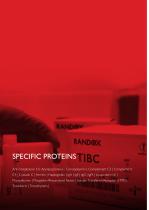 Website:
Randox Laboratories
Website:
Randox Laboratories
Group: Randox
Catalog excerpts

SPECIFIC PROTEINS EXCELLENT MEASUREMENT OF SPECIFIC PROTEINS
Open the catalog to page 1
SPECIFIC PROTEINS Anti-Streptolysin O | Apolipoproteins | Ceruloplasmin | Complement C3 | Complement C4 | Cystatin C | Ferritin | Haptoglobin | IgA | IgE | IgG | IgM | Lipoprotein (a) | Microalbumin | Myoglobin Rheumatoid Factor | Soluble Transferrin Receptor (sTfR) | Transferrin | Transthyretin | For ordering information please see page 10
Open the catalog to page 2
BENEFITS ANTI-STREPOLYSIN O APOLIPOPROTEIN A-I APOLIPOPROTEIN A-II APOLIPOPROTEIN B APOLIPOPROTEIN C-II APOLIPOPROTEIN C-III APOLIPOPROTEIN E COMPLEMENT C3 COMPLEMENT C4 CRP FULL-RANGE CRP HIGH-SENSITIVITY CRP CYSTATIN C FERRITIN HAPTOGLOBIN IMMUNOGLOBULIN A IMMUNOGLOBULIN E IMMUNOGLOBULIN G IMMUNOGLOBULIN M LIPOPROTEIN (A) MICROALBUMIN MYOGLOBIN RHEUMATOID FACTOR SOLUBLE TRANSFERRIN RECEPTOR (STFR) TRANSFERRIN TRANSTHYRETIN (PREALBUMIN) ORDERING INFORMATION A-Z PORTFOLIO OF REAGENTS GLOBAL DIAGNOSTIC SOLUTIONS PROVIDER CONTACT US UNIQUE feature NICHE product When you see this symbol you...
Open the catalog to page 3
Benefits of Randox Reagents Randox offers an extensive range of third party diagnostic reagents which are internationally recognised as being of the highest quality; producing accurate and precise results. We have an extensive test menu of over 100 assays, covering over 100 disease markers including: antioxidants, diabetes, cardiology & lipid testing, clinical chemistry, specific proteins, therapeutic drug monitoring and veterinary testing. A wide range of formats and methods are available providing greater flexibility and choice for any laboratory size. In addition to flexible pack sizes...
Open the catalog to page 4
Anti-Strepolysin O What is Anti-Steptolysin O? Streptolysin O (SLO) is a lethal, exocellular protein produced by Group A Streptococcal bacteria. The SLO toxin lyses erythrocytes and many other animal cells by disruption of the cytoplasmic and similar membranes. Consequently, antistreptolysin O antibodies (ASO) are produced by the host to neutralise the haemolytic action of the SLO. Levels of ASO in serum are dependent on the age of the patient, geographical location and the local incidence of streptoccocal infection. The upper limit of the normal range, internationally, is 200lU/ml as this...
Open the catalog to page 5
Apolipoprotein A-I What is APO A-1? Apo A-I is the major protein component of HDL particles in plasma and plays a role in lipid metabolism. Chylomicrons secreted from the intestinal enterocyte also contain Apo A-I, but it is quickly transferred to HDL in the bloodstream. Clinical Significance The chief role of Apo A-I is the activation of lecithin cholesterol acyl transferase (LCAT) and the capture and removal of free cholesterol from hepatic tissues, also known as reverse cholesterol transport. Apo A-I is therefore non-atherogenic, showing an inverse relationship to cardiovascular risk....
Open the catalog to page 6
Apolipoprotein A-II What is APO A-II? Apo A-II is a major constituent of High Density Lipoprotein (HDL) particles and plays an important role in the reverse cholesterol transport and lipid metabolism. The increased production of Apo A-II promotes atherosclerosis by decreasing the proportion of anti-atherogenic HDL containing Apo A-I. Clinical Significance Increased production of Apo A-II promotes atherosclerosis by decreasing the proportion of anti-atherogenic HDL containing Apo A-I. Benefits of the Randox A-II Assay • Wide measuring range of 6.75-61.1 mg/dl for the accurate detection of...
Open the catalog to page 7
Apolipoprotein B What is Apo B? Apo B is a component of LDL cholesterol and enables tissue cells to take up cholesterol. Apo B is considered atherogenic making it a useful risk marker for CVD. Clinical Significance Elevated levels of Apo B correlates with an increased risk of CVD, even when total and LDL cholesterol levels are within the normal range, making Apo B an important risk marker. Benefits of the Randox Apo B Assay • Wide measuring range of 9.37 - 233 mg/dl for the accurate detection of clinically important results Automated immunoturbidimetric assay eliminating the need for any...
Open the catalog to page 8
What is Apo C-II? Apo C-II acts as a co-factor for lipoprotein lipase, an enzyme that hydrolyses triglycerides in chylomicrons and vLDL Lipoprotein lipase cannot function without Apo C-II; it is essential for the normal triglyceride breakdown. If an individual is deficient in Apo C-II, they would experience a build up of triglycerides and subsequent hypertriglyceridemia. Clinical Significance Patients have been identified with excessive hypertriglyceridemia due to a deficiency in Apo C-II. Conditions associated with Apo C-II and hypertriglyceridemia include: chylomicronemia, xanthomas, and...
Open the catalog to page 9
Apolipoprotein C-III What is Apo C-III? Apo C-III inhibits the action of lipoprotein lipase and as a result modulates the uptake of triglyceride-rich lipoproteins. Clinical Significance Elevated levels of Apo C-III are associated with both primary and secondary hypertriglyceridemia. Genetically determined Apo C-III deficiency in humans has shown to increase the rate of triglyceride clearance from the plasma by 6 to 7-fold. Elevated Apo C-III levels have been reported in many pathological conditions including type 2 diabetes, hyperbilirubinemia, kidney deficiency and decreased thyroid...
Open the catalog to page 10
What is Apo E? Apo E is a protein synthesised mainly in the brain and to a lesser extent in the spleen, lungs, adrenal glands, ovaries, kidneys, muscle cells and macrophages. Apo E’s functions include the transport of triglycerides to the liver tissues and the distribution of cholesterol between cells. Clinical Significance Elevated levels of Apo C-III are associated with both primary and secondary hypertriglyceridemia. Genetically determined Apo C-III deficiency in humans has shown to increase the rate of triglyceride clearance from the plasma by 6 to 7-fold. Elevated Apo C-III levels have...
Open the catalog to page 11
Complement C3 What is Complement C3? Complement C3 is the most important and prevalent protein within the complement system. Complement C3 works in conjunction with antibodies and other factors to protect the body from invasion by pathogens. When activated by either the classical or alternative pathway complement C3 acts on biological membranes and may cause cell death. Clinical Significance Decreased complement C3 levels are important in determining inherited or acquired deficiencies and may increase the susceptibility to infections or developing autoimmune disorders. Conversely, levels...
Open the catalog to page 12All Randox Laboratories catalogs and technical brochures
-
LT735 Vivalytic Overview
32 Pages
-
Acusera New Controls
8 Pages
-
Acusera 24.7
24 Pages
-
Acusera Third Party Controls
108 Pages
-
Acusera SMART Controls
12 Pages
-
Company Overview
40 Pages
-
Reagents Brochure
64 Pages
-
sdLDL-C
8 Pages
-
RX SERIES ANALYSER OVERVIEW
24 Pages
-
RX modena
20 Pages
-
RX misano
20 Pages
-
RX Daytona Plus
20 Pages
-
Rx Imola
20 Pages
-
RX Monaco
20 Pages
-
2024 Product List
64 Pages
-
LT107 Evidence Investigator
32 Pages
-
VeraSTAT-V
16 Pages
-
LT033 RIQAS Explained
64 Pages
-
VERASTAT
16 Pages
-
Endocrine Array
4 Pages
-
Cerebral Arrays
4 Pages
-
Thyroid Arrays
4 Pages
-
Respiratory Multiplex Array
8 Pages
-
LT253 Molecular Diagnostics
20 Pages
-
LT367 FH Array Brochure
4 Pages
-
The role of EQA in QC
8 Pages
-
Basic QC Stastics
8 Pages
-
Commutability Guide
4 Pages
-
How to measure uncertainty
8 Pages
-
ISO 15189 Educational Guide
8 Pages
-
Troubleshooting QC Errors
8 Pages
-
Qnostics
52 Pages
-
Adiponectin LT519
28 Pages
-
Linearity sets
12 Pages
-
Antioxidants
16 Pages
-
Cardiology & Lipid Testing
28 Pages
-
Diabetes Portfolio
28 Pages
-
Total Bile Acids
4 Pages
-
VIVALYTIC
30 Pages
-
RANDOX DISCOVERY
36 Pages
-
HbA1c
2 Pages
-
Preparing QC
1 Pages
-
Point of Care Testing
12 Pages
-
LT394 Using QC Multirules
1 Pages
-
Guide to running QC
1 Pages
-
Tumour Marker Arrays
4 Pages
-
Which QC is the Right QC
8 Pages
-
How often is right for QC
6 Pages
-
Cardiac Risk Multiplex Array
4 Pages
-
LT241 Metabolic Array MAY15
8 Pages
-
KRAS / BRAF / PIK3CA Array*
4 Pages
-
Custom Arrays for Biochip
12 Pages
-
LT169 Cardiac Array
4 Pages
Archived catalogs
-
ACUSERA
108 Pages
-
Evidence Evolution
28 Pages
-
Evidence
16 Pages
-
Metabolic Syndrome Arrays
8 Pages
-
STI Multiplex Array
8 Pages
-
Molecular Testing
16 Pages
-
Evidence Investigator
20 Pages
-
Fertility Array
4 Pages
-
Rx Daytona
16 Pages
-
Evidence Investigator
16 Pages
-
Evidence
16 Pages





















































































